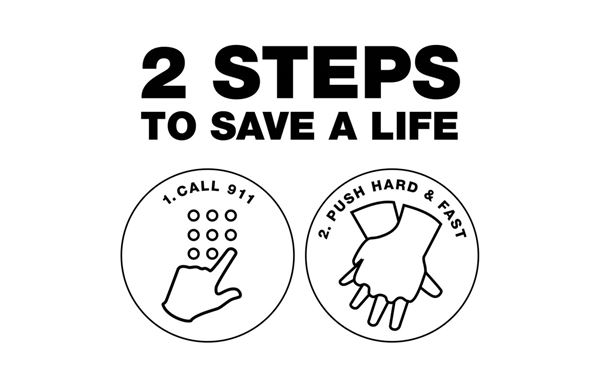Treatment of Cardiac Arrest
Quick Facts
- Cardiac arrest needs treatment right away. Rescue treatment includes CPR and the use of an AED.
- More treatment and tests may be done in the hospital.
- After a cardiac arrest, you may need a device to help restore a normal heart rhythm if ventricular fibrillation or tachycardia occurs.
Cardiac arrest can strike without warning. Do you suspect someone is experiencing cardiac arrest? The signs are:
- Sudden loss of responsiveness – The person doesn’t respond, even if you tap them hard on the shoulders or ask loudly if they're OK. The person doesn’t move, speak, blink or otherwise react.
- No normal breathing – The person isn’t breathing or is only gasping for air.
What to do
If you think the person may be suffering cardiac arrest and you're a trained lay rescuer:
- Ensure scene safety.
- Check for responsiveness.
- Shout for help. Tell someone nearby to call 911 or your emergency response number. Ask that person or another lay responder to bring you an AED (automated external defibrillator) if there’s one on hand. Tell them to hurry. Time is critical. If you’re alone with an adult who has signs of cardiac arrest, call 911 and get an AED (if one is available).
- Check for no breathing or only gasping. If the person isn’t breathing or is only gasping, begin CPR with compressions.
- Administer CPR. Push down at least two inches in the center of the chest at a rate of 100 to 120 pushes a minute. Allow the chest to return to its normal position after each push.
- Use an AED. As soon as it arrives, turn it on and follow the prompts.
- Continue CPR. Administer it until the person starts to breathe or move, or until someone with more advanced training, such as an EMS team member, takes over.
What treatment will I receive in the hospital?
Tests will be done to assess your condition. The test results can help the health care team decide on a treatment plan to reduce your risk of long-term health problems and death.
Your health care team will closely monitor your heart. They will also focus on preventing organ damage, especially to your brain.
You may receive one or more of the following treatments:
- Targeted temperature management (TTM) is a treatment to lower the body temperature to help protect the brain. Cooling blankets, cooling helmets, ice packs or other cooling methods may be used.
- Oxygen therapy helps you get enough oxygen so your organs continue to work as you are recovering.
- Extracorporeal membrane oxygenation (ECMO) treatment pumps your blood through an artificial lung. It adds oxygen and removes carbon dioxide from your blood before returning it to your body. The ECMO takes the stress off your lungs and heart to promote healing.
What other tests and treatments may I receive?
Your health care team will try to find out what caused your cardiac arrest. Some tests you may have include:
- Blood tests
- Exercise stress tests
- Imaging tests
- Cardiac catheterization
- Electrophysiology (EP) study
If you are diagnosed with coronary heart disease, treatment may include:
- Medication
- Coronary angioplasty and stenting
- Coronary artery bypass graft surgery (CABG)
These treatments help restore blood flow through narrowed or blocked coronary arteries.
Genetic testing may be recommended for you and your blood relatives. This testing is done because some conditions that can increase the risk of cardiac arrest run in families.
It’s important to find out what caused your cardiac arrest. It’s also important for your family members to find out if they may be at risk of cardiac arrest due to an inherited condition or a gene that puts them at greater risk for one.
Am I at risk of another cardiac arrest?
If you’ve had one cardiac arrest, you may be at risk of another.
Your health care team may advise that you get an implantable cardioverter defibrillator (ICD). This may happen during your hospital stay or shortly after. Or you may be asked to wear an external cardiac defibrillator. Either can save your life by providing a low-energy shock to your heart to restore a normal heart rhythm if ventricular fibrillation or tachycardia occurs.
People with an ICD have some restrictions, though many can resume their normal activities.
How do I live with an ICD?
ICD batteries usually last four to seven years. Your health care professional should check them every three to six months.
Talk to your health care team about your activities. Ask them what you can and can’t do. Also ask which types of machines or equipment you should avoid. Those with magnets and strong electrical fields may interfere with your ICD’s operation.
You should also:
- Tell airport security guards that you have an ICD. Ask them not to use handheld metal detectors on you.
- Tell your other health care professionals, including your dentist, that you have an ICD.
- Tell the doctors and nurses that you have one anytime you go to the hospital.
- Always carry a card with the details about your ICD and emergency contact information so others know that you have one in case of a medical emergency.
What if I’m anxious about living with my ICD?
It’s common for people to feel anxious or depressed, especially in the first months or year after they get their ICD. You need to know that you are not alone or without support. If you have these feelings, talk with your health care team and get help.






